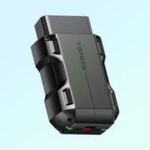Yes, the 2010 Hyundai Elantra has an OBD2 port. All vehicles manufactured and sold in the United States after 1996 are required to have an OBD2 port, also known as an On-Board Diagnostics port. This includes the 2010 Hyundai Elantra. This port allows technicians and car owners to access diagnostic trouble codes (DTCs) stored in the vehicle’s computer, providing valuable information about potential issues.
Locating the OBD2 Port on a 2010 Hyundai Elantra
The OBD2 port in a 2010 Hyundai Elantra is typically located under the dashboard, on the driver’s side, near the steering column. It’s a 16-pin trapezoidal connector, often black in color. Sometimes, it may be hidden behind a small panel or cover.
Using the OBD2 Port
The OBD2 port on your 2010 Hyundai Elantra can be used with a variety of diagnostic tools, including:
- Code Readers: These basic devices read and display DTCs, allowing you to understand what might be wrong with your car.
- Scan Tools: More advanced than code readers, scan tools can provide real-time data, such as sensor readings and engine performance parameters.
- Professional Diagnostic Equipment: Hyundai dealerships and specialized repair shops use professional-grade equipment for comprehensive diagnostics and programming.
Common 2010 Hyundai Elantra OBD2 Codes
While a complete list is extensive, some common OBD2 codes for the 2010 Hyundai Elantra include:
- P0420: Catalytic Converter Efficiency Below Threshold (Bank 1)
- P0171: System Too Lean (Bank 1)
- P0300: Random/Multiple Cylinder Misfire Detected
- P0440: Evaporative Emission System Leak Detected
- P0135: O2 Sensor Heater Circuit Malfunction (Bank 1, Sensor 1)
These codes can indicate a range of issues, from minor sensor problems to more serious engine or emission system malfunctions.
Importance of OBD2 Diagnostics
The OBD2 port plays a crucial role in maintaining your 2010 Hyundai Elantra. It enables:
- Quick Diagnosis: Identifying problems early can prevent more extensive and costly repairs.
- Emission Control: Monitoring emissions helps ensure your vehicle meets environmental standards.
- Improved Fuel Efficiency: Addressing engine performance issues can lead to better fuel economy.
- Preventative Maintenance: Regular OBD2 scans can help identify potential problems before they become major breakdowns.
By understanding how to use the OBD2 port on your 2010 Hyundai Elantra, you can take a proactive approach to vehicle maintenance and ensure it runs smoothly for years to come. If you encounter any OBD2 codes you don’t understand, consulting a qualified Hyundai technician is always recommended.
